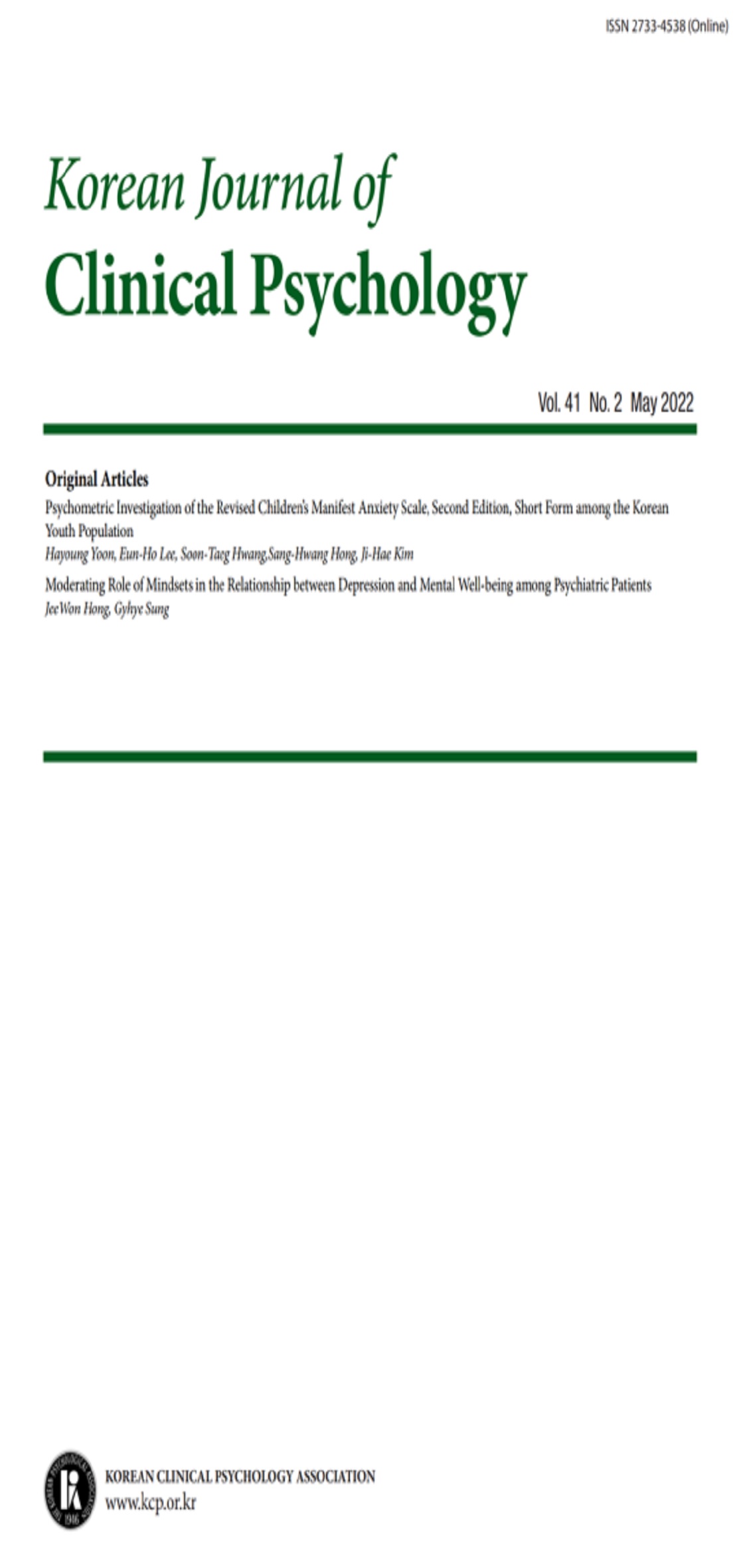open access
메뉴
open access
메뉴 E-ISSN : 2733-4538
E-ISSN : 2733-4538
본 연구는 월경 전 불쾌 증상을 겪는 미혼 여성들이 정상군에 비해, 자신의 신체증상을 부정적으로 지각하거나 증폭하여 지각하는 경향이 있는지 검증해보았다. 이를 위해 미혼 여성202명을 대상으로 39일 간의 매일 평가를 실시하여 증상군과 정상군을 선별했고, 이들의 신체 증상에 대한 인지 양식을 알아보기 위해 증상 해석검사(SIQ)와 신체감각증폭검사(SSAS)를 실시하여 집단 간 차이를 검증하였다. 분석 결과, 증상군 여성들은 신체증상 증폭지각, 신체증상에 대한 심리적 귀인 방식에서 정상군 여성들과 유의미한 집단 간 차이를 보였다. 이는 월경 전 불쾌 증상을 겪는 여성들이 자신의 신체 증상을 확대 해석하거나 부정적으로 지각한다는 것을 시사한다. 또한 로지스틱 회귀분석 결과, 신체증상에 대한 정서적 귀인 방식은 월경 전 불쾌 증상을 예측하는 변인으로, 증상 집단을 변별하는 데에 유용하다는 결과가 나타났다. 본 연구의 결과는 월경 전 증후군에 대한 인지 가설을 지지하며, 월경 전 불쾌 증상에 미치는 인지적 변인의 영향을 시사한다.
The propose of present study is to find the cognitive way how the women suffering from premenstrual dysphoric symptoms(PMDS) perceive their physical symptoms as well as to confirm that PMDS has a cognitive factor. For this purpose, this study screened 202 unmarried females for PMDS and analyzed their cognitive style of somatic symptoms. The participants wrote out Somatosensory Amplification Scale(SSAS), Symptom Interpretation Questionnaire(SIQ). As well, they rated their symptoms related to PMDS prospectively during 39 days. The daily rating operated on the web. The results show that the women suffering from PMDS are different from non-PMDS women in the respect of cognition of physical symptoms; they attributed their symptoms to emotional causes more than non-PMDS women did(p<.001) and they perceived common somatosensory exaggeratedly(p<.05). The logistic regression analysis also revealed that PMDS could be effectively predicted from the emotional attribution style. The strengths of this study include application of the prospective assessment through a computer program. Also, the result of this study supports the cognitive theory of premenstrual syndrome. However, this result is limited to be generalized to the women who suffer from premenstrual dysphoric symptoms. Thus, future studies should examine whether the result of this study can be applied to women who suffer from premenstrual dysphoric disorder.
(1998) 인지행동치료와 이완훈련이 월경 전 증후군의 감소에 미치는 효과,
(1999) 월경 전 증후군에 대한 인지행동집단치료 효과,
(1995) 월경전기 증후군-월경전기평가서와 매일평가서에 의한 평가-,
(2001) 응용 로지스틱 회귀분석-이론, 방법론, SAS 활용-,
(1998) 신체화의 인지 특성 연구 신체화 환자의 신체감각에 대한 지각 귀인 및 기억 편향,
(1998) 신체화의 인지 특성 연구 한국판 신체감각 증폭척도와 증상 해석 질문지의 신뢰도와 타당도 연구,
(1994) 후기황체기 불쾌기분장애,
(1996) 청소년에서의 월경주기에 따른 신체적, 심리적 변화 양상,
(1987) Diagnostic and Statistical Manual of Mental disorders,
(1994) Diagnostic and Statistical Manual of Mental Disorders, American Psychiatric Press
(1988) The amplification of somatic symptoms,
(1990) The somatosensory amplification scale and its relationship to hypochondriasis Journal of Psychiatric Research,
(1995) Cognitive therapy for premenstrual syndrome,
(1995) Psychological aspects of premenstrual syndrome Treatment of Functional Somatic Symptoms, Oxford university press
(1992186-192) The relationship between confirmed premenstrual dysphoria and behavior and mood changes,
(1986) patterns and correlates of daily ratings Journal of Affective Disorders,
(2002) New perspectives on the treatment of premenstrual syndrome and premenstrual dysphoric disorder Archives of Women's Mental Health,
(1992) Premenstrual symptoms:the role of irrational thinking,
(1991) A comparison of hormone therapy coping skill training and relaxation for the relief of premenstrual syndrome Journal of Behavioral Medicine,
(1983) Workshop on premenstrual syndrome Cosponsored by the centre for studies of affective disorders and the psychobiological processes and behavioral medicine section,
(1992) Cognitive model of premenstrual syndrome,
(1991) Attributions of common somatic symptoms,
(2002) Premenstrual dysphoric disorder as the most severe form of the premenstrual syndrome Geburtshilfe und Frauenheilkunde,
(1988) Changes in plasma hormones across the menstrual cycle in patients with menstrually related mood disorder and in control subjects American Journal of Obstetrics and Gynecology,
(1993) Thyroid function in women with premenstrual syndrome Journal of Clinical Endocrinology & Metabolism,
